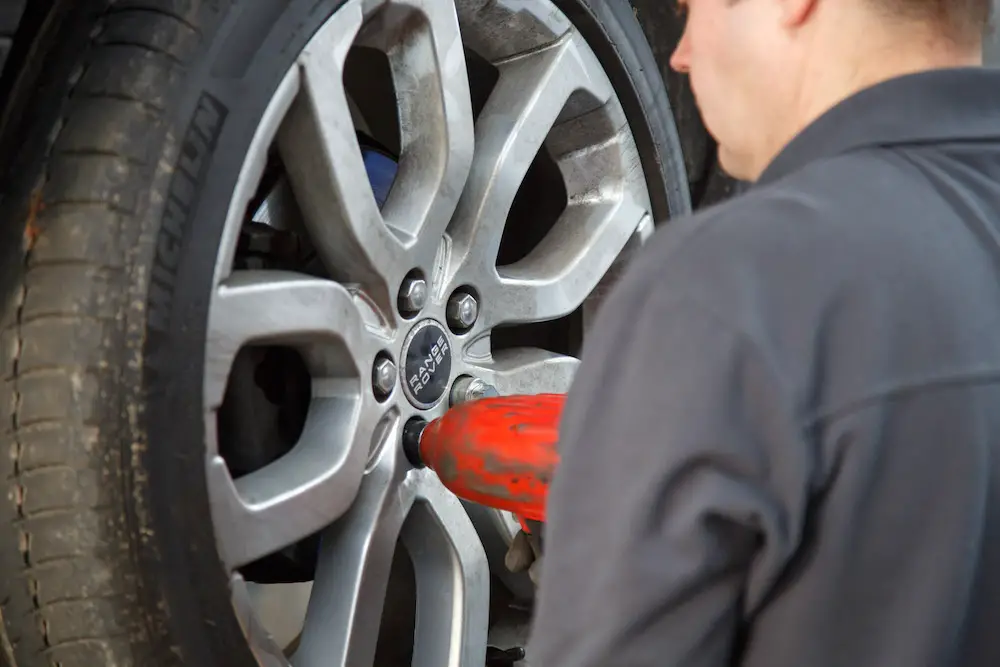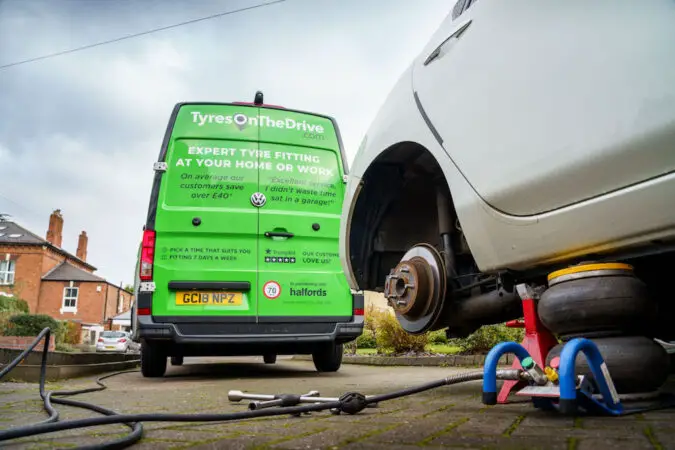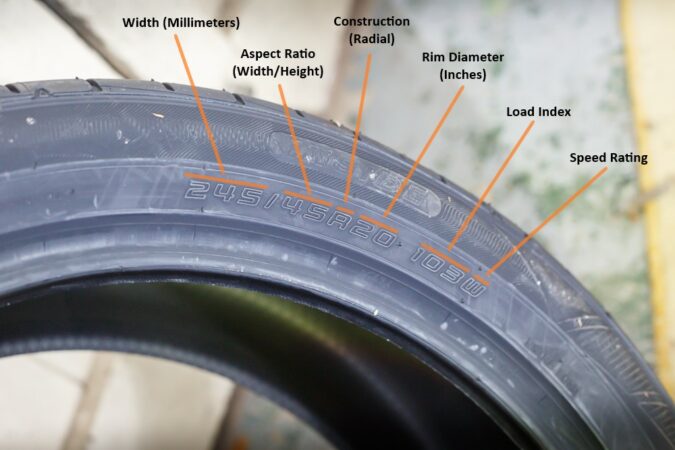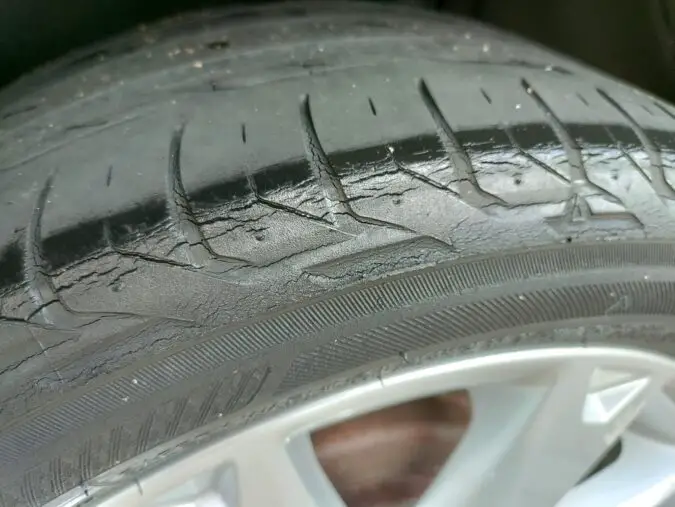Few things are as panic-inducing or as anxiety-setting as getting a flat tire and being left stranded in the middle of nowhere. But at the very least, a situation like this can be salvaged simply by changing it out for a spare. The bad news there is that few modern cars come with a full-sized spare tire. They instead feature what’s known as a donut spare tire. So then, are these good enough to drive with?
At a glance, it’s easy to imagine why you’d be hesitant to use a donut spare tire – aka a ‘space saver’ tire. They’re far smaller and look out of proportion compared to regular tires. Sometimes, I’d wonder if they’d even fit on your car at all. These doughnuts are usually made for short-distance driving and at lower speeds. With that being said, most people still use these wrong, so let’s get into how…
Spare Tire Donut
First off, let’s look at what these donut spare tires are, and how come automakers have substituted perfectly good full-sized spares for them. In other parts of the world or depending on what the car’s owner’s manual says, it’s otherwise called the ‘space saver tire’ or ‘compact spare tire’. That should give you enough clues as to why most manufacturers fit their cars with donut spare tires, as they’re:
- Smaller – They’re significantly tinier compared to a full-sized spare that’s meant to replicate your other tire sizes, 1-to-1. By the virtue of being smaller, this affords you more room in the trunk (where spares are often kept) to store other things. Donut spare tires are smaller in diameter and skinnier than regular tires.
- Lighter – With its compact form factor, a donut spare tire is also lighter than a full-sized spare. That means less mass weighing your car down. Consequently, saving weight entails more fuel savings (i.e. higher MPGs), and slightly better performance. Donut spare tires can weigh half that of a full-sized spare.
- Cheaper – This is more of a benefit to the automakers than to you, but a donut spare tire is generally cheaper to make and include. After all, there’s less substance in a doughnut compared to a full-sized spare. However, it’s an upside to you cost-wise whenever you need to replace it.
Before we go any further, let us preface this by saying that you shouldn’t be driving with donut spare tires. At least, not for too long. Doughnuts are included as a temporary fix, and should only be fitted so that you could drive to the nearest tire shop and get your regular tire patched up or replaced. It’ll compromise your handling, limit your speed, and aren’t as durable as normal tires, otherwise.
Full Size Spare Tire
On the other hand, we have a full-sized spare tire. Unlike specially-built and miniaturized doughnuts, full-sized spare tires are essentially the same type, size, and shape as your regular tires. Compared to a donut spare tire, full-sized ones are much sturdier and more stable to drive on. Additionally, they’ll last longer once they’re installed and would allow you to drive much faster with them fitted.
Nevertheless, it’s a good idea to consult your owner’s manual to understand the exact threshold of a full-sized spare tire that’s been included with your car. Some spare tires are more robust than others, and you’ll typically find one of two types of full-sized spares:
- Matching – As the name implies, this type of full-sized spare is matched exactly to your regular tires. As such, it’s a good idea to have them regularly rotated alongside your other tires. Moreover, these matched tires would be more durable on the road, and you could drive on them for far longer.
- Non-Matching – In contrast, non-matching full-sized spare tires are nearly similar to a regular set of tires, but not quite. Their tread depth is typically shallower than a regular tire, so they won’t last for too long. Yet, their oft-lightweight design makes them easier to install when you need to.
That said, and no matter how durable full-sized spares are compared to donut spare tires, it’s a bad practice to treat them as replacements for your regular set. As with doughnuts, full-sized spare tires have a limited lifespan and should be seen as no more than a temporary fix until after you’ve visited a tire shop and had a new tire installed. Although, full-sized spares do permit you more time.
Full Size Spare Tire Vs Donut
Having mentioned that, here’s a rundown on the pros and cons of both full-sized spares and donuts…
Pros Of Donut Spare Tires
- They’re small, so your car’s luggage and cargo space aren’t as compromised. While probably not that significant in the real world, you could fit more stuff in the trunk than you ordinarily can with a full-sized spare. In smaller cars especially, practically halving the dimensions of the spare tire could open up a decently large compartment.
- Compared to full-sized tires, they’re comparatively very lightweight. Over the long run, this can make somewhat of a difference to your car’s fuel economy. Again, it’s not much, but some have estimated that removing a 50lbs full-sized spare saved improved MPGs by 1%. So, cutting this down to a donut spare tire (about half the weight – roughly 25lbs) might result in a tiny improvement.
- It’s easier to store, remove, and install. While the process of installing a donut spare tire is similar to a regular tire or a full-sized spare, a doughnut is much lighter. This means that needing to carry that tire out of its storage space in the trunk is less tiresome. The process of installing a donut is made a bit easier owing to its lighter weight, as well.
- They’re much cheaper than a full-sized spare, mostly thanks to how much material you’re saving. It’s a double-edged sword, as you’re getting a lower speed limit, range, handling, and durability when it compares to a full-sized spare. But for a temporary short drive, it’s good enough. And, if you need to replace it in your trunk once you’re done, a donut spare tire costs far less.
Cons Of Donut Spare Tires
- Handling is compromised, due to how small they are. This is especially noticeable if you fit the donut spare tire onto the front wheels. The lack of contact patch on such skinny tires means that you’re not getting as much traction as a regular tire or full-sized spare. With its lack of grip, be wary of driving with them on wet, rainy, greasy, or snowy roads.
- Again, the diminutive size of donut spare tires also impacts the wear rate of your car’s suspension and steering. They’re much smaller than your other tires, so most of your car’s mass, strain, as well as its wear and tear will be put more toward one side. In other words, it’s not evenly spread out, which can cause premature or accelerated wear.
- A lackluster rubber compound, which doesn’t match up to regular tires or even full-sized spares. Thus, they’re not able to take as much abuse. Drive it for too long (at most, just 70 miles), and their treads would start wearing down rapidly. This is exacerbated if you drive on poor-quality roads, with many potholes, speedbumps, or debris. Similarly, that would wear out donut spare tires pretty quickly.
- Very limited top speed (at most, no faster than 50mph or so), when you’re driving on doughnuts. It’s made to only be a temporary fix, and last just long enough until you get to the nearest tire shop. Due to that intent, they’re not made to survive high-speed driving, and doing so is very dangerous. Its lack of traction makes it unsuitable to drive at highway/freeway/interstate speeds.
Pros Of Full Size Spare Tires
- Since they’re designed similarly to regular tires, you can use them as though they’re normal tires. An added note of caution – it’s still a good idea to stop by a local tire shop or workshop to have the tires checked. If stored for a long time and not regularly maintained, full-sized spare tires may have issues such as a lack of tire pressure, physical damage, or otherwise.
- Your car’s full-sized spare tire would easily outlast donut spare tires for range – most full-size spares are good for around 100 miles. Plus, you could run these at higher speeds, too. Again, they ought to be treated as a temporary fix. So, have it assessed by a technician as soon as possible to make sure that they’re good to drive with.
- Compared to donut spare tires, full-sized spares are of much higher quality. Hence, they could easily take on use and abuse, as though they’re regular tires. Moreover, they have more cushioning, which is better suited for soaking up bumps and potholes. Better still, they won’t compromise your vehicle’s handling, traction, or dynamics, as their contact patch and grip should be similar to normal tires.
- Another benefit of being equal in size to your car’s regular tires is that they won’t accelerate wearing out your wheel assembly, suspension, or steering. Your car’s day-to-day weight and load would thus be supported more evenly with full-sized spare tires. To ensure that it drives just as well, make sure that you regularly rotate your spare tires, alongside your regular ones, too.
Cons Of Full Size Spare Tires
- They’re expensive, significantly so compared to a donut spare tire. After all, you’re essentially buying a brand new tire. By comparison, donut spare tires can be found for as little as $50, while a new full-sized spare tire may cost at least $100. When there is a flat tire, you’re certainly able to get more out of a full-sized spare – longer range, higher top speed, better handling, etc. But, it’ll cost you more.
- Side-by-side against doughnuts, a full-sized spare tire usually weighs around twice as much. First off, this makes swapping out the tires more of an exercise. It’ll take some muscle to remove the full-sized spare from its storage space in the trunk. And once you’re done with that, positioning it and holding it in place to fit the full-sized spare onto the car will be a bit more challenging.
- Another downside with full-sized spares is that they’re much larger than doughnuts. On a day-to-day basis, that means you’re sacrificing a fair amount of luggage space. This is particularly a concern for those driving smaller cars. One might argue that this lost space can be annoying, especially since it’s not going to be often that you’ll need a spare. Yet, you’re trimming down a lot of cargo capacity.
Donut Spare Tire Size
A couple of quick questions concerning donut spare tire sizes (and their answers)…
- Are donut spare tires universal? – No, they’re not. In other words, you can’t simply interchange donut spare tires between vehicles, even if they technically fit. These doughnuts are designed to specifically support the load and weight of one specific make or model of a vehicle.
- Are all donut spare tires of the same size? – No, they’re all different sizes. Again, you can’t change the doughnuts on one car with that of another different vehicle. Each doughnut has varying tread width, material, load index, height, diameter, and sizing, which you can find stamped on the sidewall.
- Will a donut tire fit any car? – No, you can’t. Once more, the doughnuts on your car were designed to support the load, dimensions, and specifications of your car alone. Thus, you can’t easily exchange your donuts with ones from another car, even if the lug nut holes and patterns match.
To give you an idea of how large (or small) a donut spare tire is, here’s a size chart for Goodyear’s Convenience Spare brand of doughnuts…
NOTE: You can read our quick guide on tire size charts and how to read those size markings on your sidewall. This can be helpful if you’re trying to understand what your spares are capable of handling, or if you need to replace them.
Donut Spare Tire Size Chart
| Size | Diameter | Width | Rim Range |
Measured Rim |
Tread Depth |
Load Range |
Max Load |
Max psi |
Weight |
|---|---|---|---|---|---|---|---|---|---|
| T115/70D15 90M SL BSW |
21.4″ | 4.8″ | 4-4″ | 4″ | 5/32″ | SL | 1323 lbs | 60 psi | 8 lbs |
| T155/90D16 110M SL BSW |
26.8″ | 6″ | 4-4″ | 4″ | 4/32″ | SL | 2337 lbs | 60 psi | 18 lbs |
| T155/90D16 100M LL BSW |
27″ | 6″ | 4-4″ | 4″ | 4/32″ | LL | 1764 lbs | 60 psi | 16 lbs |
| T135/70D17 92M LL BSW |
24.8″ | 5.4″ | 4-4″ | 4″ | 5/32″ | LL | 1389 lbs | 60 psi | 11 lbs |
| T135/80D17 103M SL BSW |
25.5″ | 5.4″ | 4-4″ | 4″ | 4/32″ | SL | 1929 lbs | 60 psi | 10 lbs |
| T135/90D17 104M SL BSW |
26.6″ | 5.3″ | 3.5-4.5″ | 4″ | NA | SL | 1984 lbs | 60 psi | 13 lbs |
| T145/80D17 97M LL BSW |
26.1″ | 5.7″ | 4-4″ | 4″ | 5/32″ | LL | 1609 lbs | 60 psi | 13 lbs |
| T155/70D17 110M SL BSW |
24.9″ | 6″ | 4-4″ | 4″ | 5/32″ | SL | 2337 lbs | 60 psi | 13 lbs |
| T155/80D17 101M LL BSW |
NA | NA | NA | NA | NA | LL | 1819 lbs | 60 psi | 13 lbs |
| T165/80D17 104M LL BSW |
27.6″ | 6.3″ | 4-4″ | 4″ | 5/32″ | LL | 1984 lbs | 60 psi | 17 lbs |
| T175/90D17 109M SL BSW |
29.5″ | 6.8″ | 4.5-4.5″ | 4.5″ | 4/32″ | SL | 2271 lbs | 60 psi | 18 lbs |
| T145/80D18 99M LL BSW |
27.1″ | 5.7″ | 4-4″ | 4″ | 4/32″ | LL | 1709 lbs | 60 psi | 15 lbs |
| T155/85D18 115M SL BSW |
NA | NA | NA | NA | 5/32″ | SL | 2679 lbs | 60 psi | 15 lbs |
| T175/90D18 111M LL BSW |
30.4″ | 6.9″ | NA | NA | NA | LL | 2403 lbs | 60 psi | 19 lbs |
| T165/90D19 119M SL BSW |
30.7″ | 6.5″ | NA | NA | NA | SL | 2998 lbs | 60 psi | 21 lbs |
Max Speed For Donut Spare Tire
Another couple of questions, especially on how fast (and far) can you go with donut spare tires…
- How fast can you drive with donut spare tires? – No more than 50mph, although some might go as high up as 55mph. You should ideally refer to your owner’s manual to see how fast it could actually go. Nevertheless, be wary to keep your top speed limited while running on doughnuts.
- How long can you drive on a donut? – Not much more than 70 miles or so miles, preferable less. So, be diligent about how many more miles before the doughnuts give up, which should be noted in the owner’s manual. All the while, it’s best to have them replaced as soon as possible.
In summary, your top speed should be limited to just 50mph – ideally less – when you’re driving on a donut spare tire. One neat trick, instead of staring constantly at the speedometer, if you want to be certain that you’re not exceeding this limit, is by setting the cruise control. This way, your car would automatically maintain a top speed of 50mph (or whatever speed it is that you’ve set it to).
On a side note, while you can drive up to 50mph, you should be careful when driving in the rain or if the road is coated with ice and snow. Donut spare tires can’t grip on the road as well as regular tires owing to their skinny profile and low-quality rubber. Therefore, it’s much easier to skid, lose control, and notice a longer stopping distance under braking with doughnuts. So, be very, very careful.
Donut Spare Tire Replacement
And, how about a couple more questions on donut spare tire maintenance…
- How much does a donut spare tire cost to replace? – The cheapest place to get a donut spare tire will be your local tire shop. They’d sell these for anywhere from just $50 to all the way up to $300. While you’re buying a new doughnut, remember to make sure that it matches your car’s make and model.
- Can you repair a donut spare tire? – No, you can’t. Unlike regular tires, the rubber compound on your doughnuts is not as robust or thick, nor is the tread as deep. Therefore, and assuming that a donut spare tire has been punctured, plugging it won’t work, as it might not hold well on a doughnut.
- How long does a donut tire last? – Just to be safe, have your spare tire – either a donut or a full-sized one – replaced after 10 years. Even if it’s been left unused and untouched, the rubber compound will continue to naturally (chemically) degrade. As such, compromises its structural integrity.
- Do you have to put air inside a donut spare tire? – Yes, they should be maintained and serviced like a normal tire. Therefore, you’ll have to stay on top of keeping it inflated, even if it’s unused. You’ll have to check the owner’s manual to confirm, but their recommended air pressure is typically 60psi.
So, if you need a donut spare tire replacement, that’ll cost you at least $50. Although, the majority of tire shops and auto parts stores charge $100 or more for one. While you’re there, and we’ll stress this again, make sure that you get a doughnut spare made for your car’s exact make and model. As we’d highlighted earlier, these compact spares aren’t interchangeable, so you can’t mix and match them.
Frequently Asked Questions
That just about does it for this guide on donut spare tires, and hopefully, we’ve provided some useful tips for you. However, if you’re still left unanswered, perhaps our FAQs here might help…
Can I Drive 200 Miles On A Donut
Absolutely not, donut spare tires are not made to survive 200 miles. The majority of doughnut spares are usually good for around 70 miles, as a rule of thumb. More specifically, they can last anywhere in the range of 60 or up to 100 miles. It’s a good idea to check your owner’s manual to understand how far you’re able to go with them. In all, you should have them replaced as soon as possible.
How Many Miles Can You Drive On A Donut
Most donut spare tires are rated to travel no further than 60 or even up to 100 miles. This varies a lot depending on the tire itself, but as a general rule of thumb, you shouldn’t go further than 70 miles. A doughnut is made from an inferior rubber compound and isn’t made to be as durable as regular tires. In so doing, they wear out very quickly once you start driving on them.
How Fast Can You Drive On A Donut
Most donut spare tires shouldn’t be driven any faster than 50 to 55mph. This is partly thanks to their skinny profile, which significantly reduces the effective contact patch compared to regular tires. With a lackluster grip and simplistic construction, doughnuts are severely compromised in handling. More crucially, your car’s braking/stopping distance will be expanded, so be wary when driving with them.
Where Can I Buy A Donut Spare Tire
The cheapest place where you can buy a donut spare tire would be the local tire shop. If you’re very lucky, you might be able to find one for as little as $50. Although most doughnuts cost at least $100, others can cost upwards of $300. When you’re getting one, remember to find a doughnut that matches and was made for your car’s exact make and model. Doughnuts aren’t interchangeable.
Can You Repair A Donut Spare Tire
Unfortunately, donut spare tires can’t be repaired. The rubber compound on a doughnut is inferior to that of a regular tire. In general, the rubber itself isn’t thick, and the treads aren’t as deep. When you do try to plug them in the event of any punctures or damage, that plug might not hold for long. They were made for temporary use only, so if they’re damaged, they have to be replaced outright.





